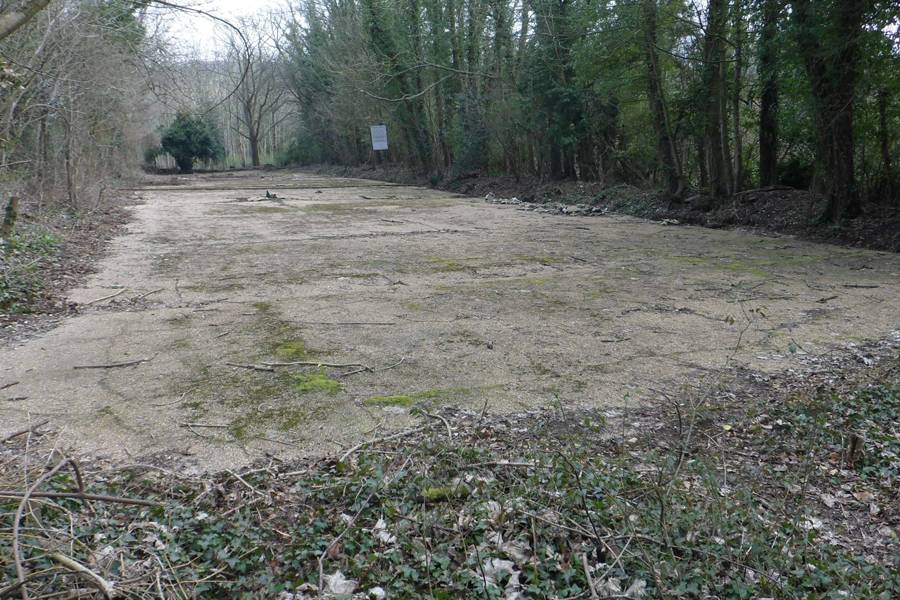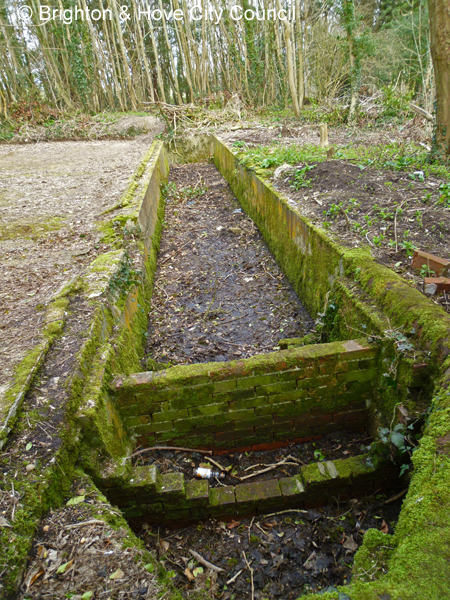
Bevendean History Project

Stanmer Rain Water CatcherA
Rain Water Catcher was built between 1870 and 1875, on the slope behind
Stanmer House to provide the residents and visitors to Stanmer House
with good quality drinking water. It also meant that they were
able to enjoy some of the country's first flushing toilets.

The Rain Water Catcher in April 2014 looking down the slope.
The
Water Catcher is now a Grade II listed Victorian construction and is
thought to be only one of two remaining in the UK. It provided
gravity-fed water to the house, walled gardens, stables and village
through a series of complex underground tanks and pipes.
The Water catcher is approximately 70 metres long and approximately 12 metres wide. It was built to the design of Thomas Jones, the estate foreman, and enlarged to the west in the 1890s. Concrete was laid on top of large flints with bricks, cement and a mixture of tar and sand being used in the construction. The surface was coated with tar and sand in the 1930s.
There are occasional breaks, acting as channels, with a continuous gulley to one side and a brick break marking the boundary of the first build, approximately 25 metres from the west. There is a brick and cement tank at the east end, to the full width of the catch and approximately 1 metre deep, with an overflow at the north-east corner and the remains of the filter system to the south end.

The Water catcher is approximately 70 metres long and approximately 12 metres wide. It was built to the design of Thomas Jones, the estate foreman, and enlarged to the west in the 1890s. Concrete was laid on top of large flints with bricks, cement and a mixture of tar and sand being used in the construction. The surface was coated with tar and sand in the 1930s.
There are occasional breaks, acting as channels, with a continuous gulley to one side and a brick break marking the boundary of the first build, approximately 25 metres from the west. There is a brick and cement tank at the east end, to the full width of the catch and approximately 1 metre deep, with an overflow at the north-east corner and the remains of the filter system to the south end.

The rain water collecting channel and filtering tank
at the bottom of the slope photographed in March 2016.
at the bottom of the slope photographed in March 2016.
Brightons Water Supply
In
July 1872, under the terms of the Brighton Corporation Waterworks Act,
the corporation purchased the Constant Service Water Company.
By 1900 Brighton Corporation had acquired three more water suppliers. Pumping-stations were constructed at Patcham in 1889; Mile Oak in 1900; Falmer in 1904; and the first electric station at Balsdean in 1936.
A pumping station in the Lewes Road was closed in 1903 and demolished due to contamination of the ground water.
The corporation proceeded to purchase farm land surrounding the town to prevent further pollution of the water supply. Bye-laws eventually extending to over 30,000 acres were made and vast areas of Downland were acquired to prevent contamination of the water supply.
Bevendean Farm and other land owned by Steyning Beard were purchased in 1913, and the Brighton Corporation purchased other farm land between the sea and the Downs when it became available.
The council bought Stanmer Park in 1947 for £225,000, to safeguard the city’s water supply.
More photographs taken in September 2021By 1900 Brighton Corporation had acquired three more water suppliers. Pumping-stations were constructed at Patcham in 1889; Mile Oak in 1900; Falmer in 1904; and the first electric station at Balsdean in 1936.
A pumping station in the Lewes Road was closed in 1903 and demolished due to contamination of the ground water.
The corporation proceeded to purchase farm land surrounding the town to prevent further pollution of the water supply. Bye-laws eventually extending to over 30,000 acres were made and vast areas of Downland were acquired to prevent contamination of the water supply.
Bevendean Farm and other land owned by Steyning Beard were purchased in 1913, and the Brighton Corporation purchased other farm land between the sea and the Downs when it became available.
The council bought Stanmer Park in 1947 for £225,000, to safeguard the city’s water supply.
